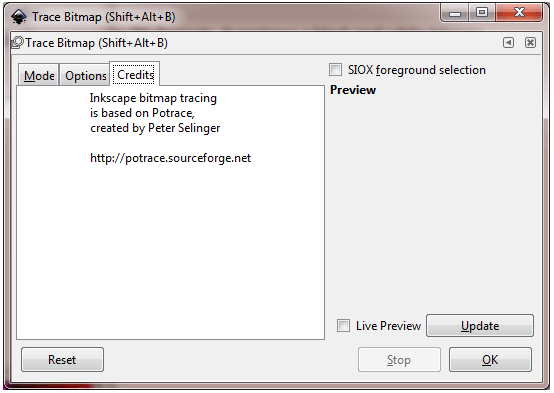

This will apply a boolean operation to delete parts of the path that lie outside the area you want. Note: If instead you want something like just the head to be the mask, after preparing the pieces as shown above and combining, you could draw a shape with the Bézier tool around the head, and do Path > Intersection. Use snapping to get the positioning accurate. Move the masked image under your traced line drawing, make sure it's at the bottom of the stack. Using our drawing templates If using your materials or not using a template Configuring units & colour mode Laser cutting Lines Vector engraving / scoring. Select both the mask and the image, and do Object > Clip > Set The Centerline Trace tool traces a single line down the middle of each part of a bitmap, and includes an option to outline any areas that are wider than a. If there is a bitmap included in the group of shapes, I would first trace a path with a thick stroke around the bitmap to have a smooth, uniformly colored edge to trace on before doing the. Rescale the image if necessary, and move it under the mask. You can now move the border to the back of the group of shapes, color the stroke or increase its thickness, or give it a fill. Now bring the raster image into Inkscape, send to the back of the stack using End.

Once you have the mask pieces prepared, select them all and do Path > Combine - sometimes Path > Union might be better if you experience any problems here - this will turn everything into a single path/shape which we can now use as a mask. If you want a more editable copy, you must trace the center of all lines manually with the Bezier Tool and assign a suitable Strokewidth. To make the lines thicker you can add a stroke. the trace (left), the trace broken apart (middle), and on the right I'm deleting the pieces I don't want to be a part of the mask. Trace Bitmap only produces filled shapes, not single strokes. Then break apart and delete the pieces that you don't want to be part of the mask.Į.g. To get a mask you will need to prepare something separately from the line drawing.īest idea is to create a duplicate of the trace to work on. These options and their sub-methods are: Single Scan This option is generally good at tracing simple images, so it is resource friendly. You may need to convert your object to a path first to be able to use any of these tools, also via the Path menu.
#INKSCAPE TRACE BITMAP LINE THICKNESS HOW TO#
In this article, we will explore how to use the trace bitmap tool, as well as the option under this menu. There is Path > Inset to reduce the thickness, and Path > Dynamic Offset that displays a handle you can then move to grow or thin your outline. When you have made your trace, it's now made of vectors. Optimize Limitations Conclusion Trace Bitmap (Shift+Alt+B) This tool comprises two options, and each option has other sub-methods. Inkscape is a vector graphics editor, but Trace Bitmap is a tool with underlying algorithms to convert a raster image to vector paths.


 0 kommentar(er)
0 kommentar(er)
